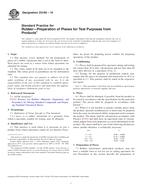We need your consent to use the individual data so that you can see information about your interests, among other things. Click "OK" to give your consent.
ASTM D7050-04(2014)
Standard Practice for Rubber from Natural Sources—Sampling and Sorting Bales Based on Predicted Processing Properties
STANDARD published on 1.5.2014
The information about the standard:
Designation standards: ASTM D7050-04(2014)
Note: WITHDRAWN
Publication date standards: 1.5.2014
SKU: NS-37425
The number of pages: 2
Approximate weight : 6 g (0.01 lbs)
Country: American technical standard
Category: Technical standards ASTM
The category - similar standards:
Annotation of standard text ASTM D7050-04(2014) :
Keywords:
hard rubber, natural rubber, processability, processing properties, sampling, soft rubber, sorting bales, ICS Number Code 83.060 (Rubber)
Additional information
| Significance and Use | ||||||||
|
3.1 In accordance with Specification D2227, shipments of TSR10 and TSR20 must meet a minimum initial Wallace plasticity (Po) of 30 to be accepted. However, even with this minimum restriction, the uncured viscoelastic or “processability” properties are allowed to vary greatly. This variation in properties can significantly affect the quality and efficiency of a factory operation. 3.2 Bales of TSR10 or TSR20 which are lower in their uncured elastic quality (“soft” rubber) in some cases may impart better processing properties to tire innerliners, cushion gums, and sidewalls. “Soft” bales sometimes impart better building tack, better mold flow, and lower extrusion die swell with better dimensional stability. Also, these “soft” rubber bales may dissolve faster in solvents for adhesion dipping. 3.3 Bales of TSR10 or TSR20 that are higher in their uncured elastic quality (“hard” rubber) in some cases generate greater shearing during the initial stages of a factory mix, which result in a faster breakdown and a shorter mix cycle. 3.4 Therefore, in a factory operation, sometimes segregating TSR10 or TSR20 shipments into “soft” and “hard” categories can improve the efficiency and quality of a factory operation. |
||||||||
| 1. Scope | ||||||||
|
1.1 This practice covers the sorting of natural rubber bales of TSR10 or TSR20 in the factory according to their predicted processing performance based on differences in viscoelastic properties. 1.2 This practice determines which bales should be used in factory compounds which benefit from using “soft” natural rubber versus which work better with “hard” natural rubber. |
||||||||
| 2. Referenced Documents | ||||||||
|
Similar standards:
Historical
1.7.2010
Historical
1.12.2010
Historical
1.11.2011
Historical
1.11.2011
Historical
1.12.2010
Historical
1.11.2011
We recommend:
Technical standards updating
Do you want to make sure you use only the valid technical standards?
We can offer you a solution which will provide you a monthly overview concerning the updating of standards which you use.
Would you like to know more? Look at this page.



 ASTM D3183-10
ASTM D3183-10 ASTM D3185-06(2010)..
ASTM D3185-06(2010).. ASTM D3186-07(2011)..
ASTM D3186-07(2011).. ASTM D3187-06(2011)..
ASTM D3187-06(2011).. ASTM D3188-06(2010)..
ASTM D3188-06(2010).. ASTM D3189-06(2011)..
ASTM D3189-06(2011)..
 Cookies
Cookies
